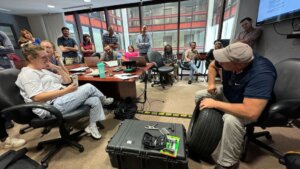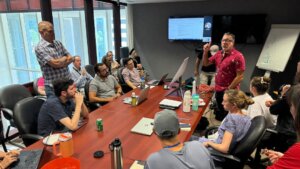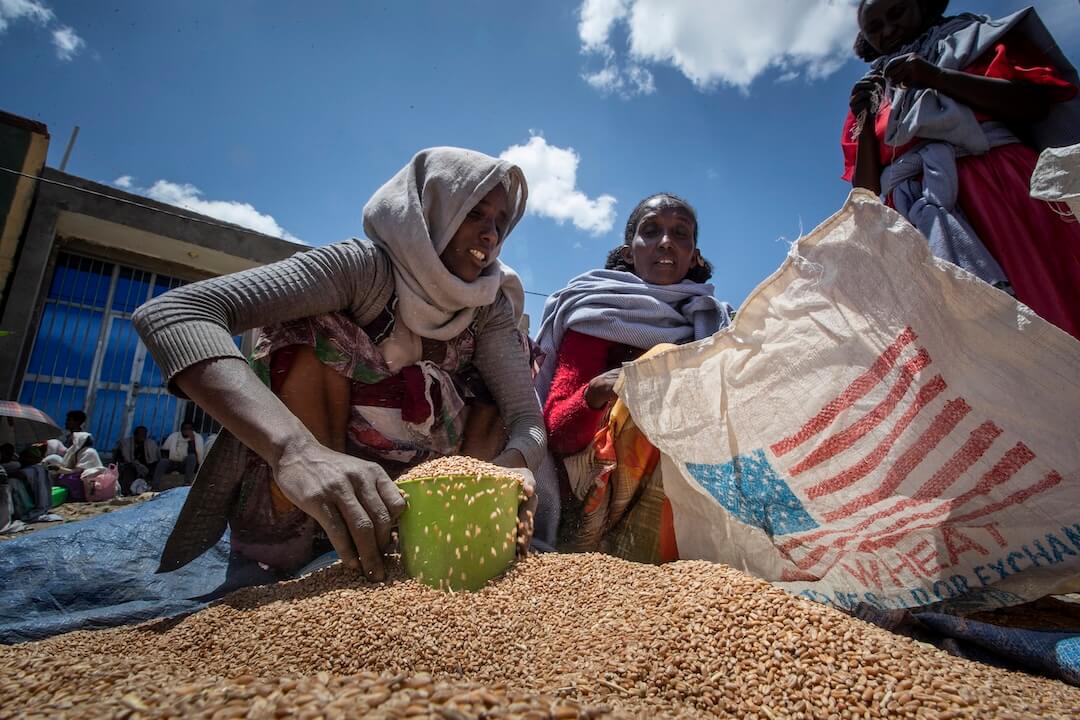Somewhere in Steinhatchee, a coastal town in Florida’s Big Bend region that had just been struck by Hurricane Idalia, two journalists stopped at an intersection. The water was really high – so high that they didn’t feel comfortable driving their rented SUV any further.
That’s when they noticed a man in a giant pickup truck. They waved him down.
Daniel Dickert, 54, had ridden out the storm inland at his mother’s house. Now he was trying to get home.
Zack Sampson and Douglas R. Clifford – an investigative reporter and a photojournalist for the Tampa Bay Times, respectively – had covered many hurricanes together before, The plan was, as always, to document the aftermath.
After Clifford flagged him down, Dickert rolled down his window.
“‘Do you mind if we jump on your truck?’” Clifford recalled asking him.
Dickert didn’t. So they jumped in with their gear.
The local man brought Sampson and Clifford to his property. The resulting story was a dispatch set hours after Hurricane Idalia ripped through the area, with the voices of Dickert and a few other residents. The lead image shows Dickert checking on his home, water at his knees.
Preparation begins early
Sampson and Clifford make up the Tampa Bay Times’ “go team one.” Go teams undergo extensive training every year and are deployed to different areas ahead of an incoming storm.
Clifford, who has been at the Times since 1998, said the goal of a go team is to reach the area that has been most affected by the storm as efficiently and safely as possible, and to document damage and interview people who rode out the storm and survived.
“I always like to tell people that our success depends on a lot of small, very good decisions that stack up to a very big result, which is that we are the first in to the areas that are most affected, and that we are able to get the most poignant and newsworthy and immediate content out of that zone before anyone else, because we prepared for that.”
Florida is now three months into hurricane season, which runs from June 1 to Nov. 30, but the Tampa Bay Times began preparing long before the season started. Staff begin thinking about it early in the year — in January or February. Chris Tisch, senior editor of breaking news, criminal justice and environment who helps lead hurricane coverage for the Times, said they do take a mental break after the season is over.
“You just kind of have to, because it’s really pretty intense generally through August, September, October. And now we’re even seeing it in November more often.”
Over time, the newspaper, which is owned by Poynter, has built what amounts to a sophisticated preparation plan for the season, complete with training for the whole staff, a hurricane committee, and an annual survey that has grown in scope.
The increased and concerted efforts to prepare staff to bring coverage to readers has earned the Times statewide recognition. In July, the Times staff received 17 awards from the Florida Society of News Editors. Among the wins was first place in the breaking news category for its coverage of Hurricane Idalia — part of its overall gold medal win. It’s the newspaper’s second year in a row in the breaking news category for hurricane coverage. Enterprise reporter Lauren Peace also received the Paul Hansell Award for Distinguished Achievement in Journalism for her reporting in 2023, some of which was from Hurricane Idalia.
Managing Editor Carolyn Fox, who oversees the Times’ hurricane preparation, said covering a huge weather event like a hurricane is one of the most important things the staff does. And she said her colleagues meet the moment.
“They know that this is going to affect a lot of people’s lives, and that that means that everyone has to pull their weight,” Fox said. “And I think the thing I am most proud of is just the fact that, in the last two years — in such a short time period of having to cover one and then the next — our staff have stepped up both times. And they’re ready to step up this year, when we know that it could be another tough year in Florida for hurricanes.”
Fox arrived at the Times in 2019, after four years at The Times-Picayune in New Orleans, where she said she received an education on how to cover major weather events by people who covered some of the biggest. (The Times announced Tuesday that Fox would be leaving the Times to take a new job in Maine, as this story was being edited).
When Tisch was a reporter, he helped report on the devastating and deadly Hurricane Katrina and other major storms. “I would say that we didn’t call them go teams, and we didn’t really make our plan a little sharper until Carolyn arrived,” Tisch said, adding that she brought some of the planning that New Orleans had done with her.

Tampa Bay Times photographer Douglas Clifford demonstrates for staffers how to plug a tire hole as part of hurricane training. (Photo: Luis Santana/Tampa Bay Times)
“That’s one thing I think every newsroom can learn from other newsrooms that have been through this: You’re never going to get it perfect. There’s always improvement you can make,” Tisch said. “There’s always tweaks and things you can learn from other newsrooms. So I think that really helped us when she came aboard.”
The teams that were sent to cover hurricanes were not as organized as far ahead of time as they are now, Fox recalled. Then COVID-19 happened, and, in 2021, the Tampa Bay Times sold its printing plant, a sturdy building where staff always worked safely during hurricanes that threatened locally. The plan that was enacted during hurricanes had to be completely redone.
Earlier and more organized
In early 2022, Fox was named managing editor of the Times, and Hurricane Ian came roaring that September. “We had a plan,” Fox said of the staff’s preparation to cover the extremely destructive Atlantic hurricane that threatened Tampa Bay before making landfall as a Category 4 in Southwest Florida. “It was definitely more organized than we had been.”
The preparation for this year’s hurricane season has been even heftier. The Times now has a hurricane committee that meets regularly from March through October. Committee members meet to discuss the latest forecasts and new equipment.
Fox also came up with the idea of having a hurricane coordinator. Last year she tapped Allison Ross, senior editor for politics and government, to serve in that role. Ross has helped coordinate housing assignments for staffers, especially those who live in an evacuation zone. She said they also conduct a survey at the beginning of the hurricane season to ask Times staffers about their housing situation. If a storm were to come to Tampa Bay, what would they need? Ross said they have a number of spreadsheets to track all this information.
The newspaper also now has five assigned go teams — one reporter and one visual person. Fox said the teams each have go-team kits, with everything they’ll need ready to go in rented Chevrolet Suburbans.
There are also five go-team editors.
“For the first time, we’re giving each go team their own editor, instead of like two go teams per editor,” Fox said, “because we learned in Idalia last year that it got too hairy for the editors to have multiple go teams in different places.”
The Times in August announced it was eliminating about 60 jobs, citing revenue shortfalls. Fox said even with the staff changes, the plan is to still have one editor per go team. There are also staff who have been trained to serve as backups to the go-team editors and teams.
Past hurricanes like Ian taught the Times staff lessons on how to strengthen their preparation approach. Because of how quickly information comes in, the newspaper has separated into two hurricane Slack channels. One channel is for people to talk amongst themselves, ask questions and drop in ideas, and for editors to share updates. The second channel is for reporters’ feeds, so that the person in charge of doing the write-through or live updates has all the information they need.
Fox doesn’t have a go team assigned to her, but said she remains in close contact with Sampson and Clifford, who she said helped her make decisions for the go teams.
During active coverage, Fox said she runs calls twice a day, sometimes three if needed, with all the editors and anyone else who wants to join. She runs a staffing document that includes a list of everyone’s jobs for the day. Michael Van Sickler, assistant managing editor/news, maps out the stories that aren’t live updates.
Fox tells her staff that she feels responsible for keeping them safe.
“Are they in a safe situation? Do we need to pull them from where they are?” she said. “I feel like, as managing editor, it’s my responsibility not only to make sure we’re doing the best coverage, but also to make sure that people on my staff are safe.”
In late July, when Tisch spoke with Poynter, he said he was worried about this hurricane season.
“Tampa Bay has been very lucky. We haven’t had a direct hit from a storm in more than 100 years,” he said. “So we’re kind of due. I love this area, and it makes me sick to think about what a storm could do here — and what kind of long term damage it could do.”
Lessons learned in the storm

Chris Urso, photo director, news and sports at the Tampa Bay Times, (standing, right) shows 2024 go team members how to work the portable Starlink satellite, which is used to transmit video, photos and feeds from the field. (Photo: Luis Santana/Tampa Bay Times)
Throughout years of weathering storms together, Clifford and Sampson have cobbled together many lessons.
For the road, they try to pack a gallon of water a day, per person. On the subject of food, Sampson recommends following Clifford’s advice: have something you like that is good for morale. For Sampson, that means Sour Patch Kids. Clifford likes preparing a special trail mix that includes his favorite granola, chocolate, fruit, nuts and sometimes coffee beans. “Just all the things that I enjoy — all my little comfort flavors and foods,” he said.
Where the go teams decide to ride out a storm is important, Clifford said.
“The goal is to be within 15 to 20 miles of landfall,” he said. That means choosing a hotel that will remain open during a hurricane and whose construction is strong enough to handle a storm, and a place where a vehicle is safe.
He said he chooses lightweight, breathable clothing when covering the aftermath of a hurricane. “Because if you wear cotton, it’s just going to remove all the heat from your body. You’re going to be really uncomfortable.”
Taking care of your feet is important. Clifford brings many socks. He stressed the importance of taking care of your body and understanding hazards. There are many of them. “And none of them are to be taken lightly,” he said. “Downed power lines, fallen street lights, fractured trees,” he said. “Building materials are really dangerous: roofing nails, boards, ceramic tiles. These are all things that can damage the vehicle, can cut your feet.”
When he and Sampson covered the aftermath of Hurricane Idalia, Clifford was covered in fuel and chemicals from the many boats in the Steinhatchee River.
Sampson said he got a pair of waders for this year’s season. Last year, his boots had not been connected to the waterproof layer on his clothing — so they got full of surge water, which he described as “pretty nasty.”
The team keeps tabs on changes and updates their plans accordingly. Over the last two years, Sampson said he and his colleagues have seen a phenomenon of storms rapidly intensifying. He noted that environment and climate reporter Max Chesnes has written about it. “There’s not a great scientific consensus on it, but what it’s done is that storms have jumped categories pretty aggressively in the 48 hours before landfall, especially in the Gulf of Mexico as they’re hitting Florida,” he said.
He and his coworkers are reading about it and discussing. They’re trying to keep tabs on it, he said, because it affects their planning.
“And so that’s something that’s a little bit different than hangs over all of this — is this shift that’s happening in storms, and how it might dictate how we deploy and what we’re prepared for based on how intense they can get and how suddenly that can happen,” Sampson said. “It feels like your decisionmaking process is getting compressed, if that makes sense.”
Sampson, who will mark 10 years as a full-time reporter for the Tampa Bay Times in September, recalled volunteering early on to help with hurricane coverage. His first was in 2016, for Hurricane Matthew.
“It was illuminating to how ill-equipped I was,” said Sampson, who grew up in New England and covered blizzards. Hurricanes, he said, were a different animal.
The biggest lesson Sampson has learned that he didn’t know before when covering hurricanes: You don’t prepare to avoid.
“You don’t prepare to perfectly insulate yourself from anything bad happening. You can never fully prepare to avoid something coming up when you’re out in a storm,” he said. “You prepare so that you’re in the best position to make a good decision when you’re out there, and you’re not dealing with stuff that you could have handled ahead of time.”






